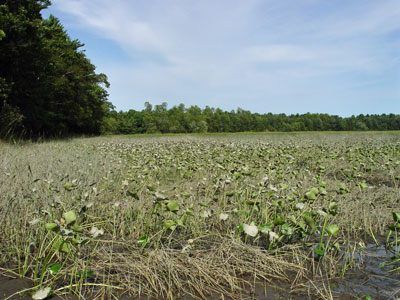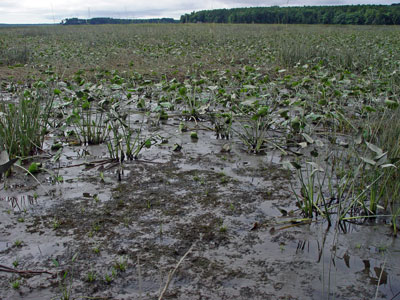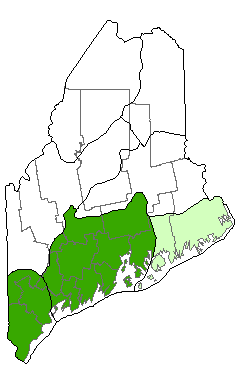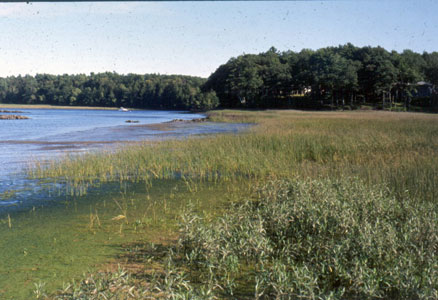DACF Home → Bureaus & Programs → Maine Natural Areas Program → Communities, Plants, and Animals → Natural Community Fact Sheets → Freshwater Tidal Marsh
Printer Friendly Fact Sheet - 900 KB pdf (Get a free copy of Adobe Acrobat Reader)
Freshwater Tidal Marsh
Scientific Name: Freshwater Tidal Marsh; State Rank: S2

- Community Description
- Soil and Site Characteristics
- Diagnostics
- Similar Types
- Conservation, Wildlife and Management Considerations
- Distribution
- Characteristic Plants
- Associated Rare Plants
- Associated Rare Animals
- Examples on Conservation Lands You Can Visit
Community Description: These tidal marshes are dominated by patchy stout herbs, typically a mixture of wild rice, softstem bulrush, and pickerelweed, often covering extensive areas. Mixed in with the tall herbs are lower forbs including several rare species. Some marshes may have mudflats dominated by forbs and low vegetation in patches among the graminoids; many have a very narrow band of low forbs near the high tide/upland interface. Brackish marsh species, such as chair-maker’s rush, may be in these marshes as well, but at least some obligate freshwater plants such as pickerelweed, common arrowhead, sweet flag, and northern water-plantain will also be present. Bryophytes are essentially absent. Back to top.
Soil and Site Characteristics: Freshwater tidal marshes are associated with major rivers, in low-gradient areas of the mid to upper tidal reaches. Freshwater inputs lower the salinity to <1 ppt. Substrate is usually mud, or mud mixed with gravel. The tidal regime affects substrate and plant zonation. Back to top.

Diagnostics: These graminoid dominated marshes occur along tidal rivers, with patches of forbs locally abundant. Obligate freshwater species are present, such as sweetflag, yellow water-lily, large yellow pond-lily, or pickerelweed. Back to top.
Similar Types: Brackish Tidal Marshes are most similar and grade into this type as salinity decreases. Grassy Shrub Marshes and Pickerelweed Marsh types can contain several of the same species, but do not occur in tidal settings. Back to top.
Conservation, Wildlife and Management Considerations: Tidal marshes are valuable wildlife habitat and have received considerable conservation attention. Heavy metals, sewage overflows, and other pollutants have degraded the substrate in many areas, but some have recovered as water quality has improved over the past decades. Many occur on or adjacent to public lands or private conservation lands. Some have been managed for waterfowl by planting wild rice. With development of the uplands that border these marshes, maintenance of appropriate wetland buffers can help reduce degradation that could result from adjacent land uses. Invasive species such as Japanese knotweed and purple loosestrife have invaded the upper reaches at some sites. The prospect of sea level rise may also put these systems at greater risk in the future.
The tidal marshes of Maine’s larger estuaries, especially Merrymeeting Bay, are important pre-migration staging habitat for thousands of waterfowl and wading birds. The rare New England siltsnail inhabits coastal marshes and small tidal rivers where the water ranges from fresh to upper brackish. Back to top.
Distribution: Upper tidal reaches of major rivers: most well known from the Kennebec and Penobscot Rivers (Laurentian Mixed Forest Province). Landscape Pattern: Large Patch, often linear. Back to top.


Characteristic Plants: These plants are frequently found in this community type. Those with an asterisk are often diagnostic of this community.
- Herb
- Chair-maker's rush*
- Common arrowhead
- Eaton's bur-marigold
- Nodding beggar ticks
- Northern water-plantain
- Parker's pipewort
- Pickerelweed*
- Softstem bulrush*
- Tidal arrowhead
- Wild rice*
- Beaked spikerush
- Eaton's bur-marigold
- Long's bitter-cress
- Parker's pipewort
- Pygmyweed
- Spongy arrowhead
- Stiff arrowhead
- Water-pimpernel
- American oystercatcher
- Black-crowned night-heron
- Least bittern
- Short-eared owl
Examples on Conservation Lands You Can Visit
| Example | County |
|---|---|
| Merrymeeting Bay Wildlife Management Area | Sagadahoc Co. |
| Muddy River Wildlife Management Area | Sagadahoc Co. |
| Swan Island Wildlife Management Area | Sagadahoc Co. |
